Even a casual observer of religious symbols will likely notice the three-letter symbol “IHS” at some point. It’s actually pretty hard to miss!
“IHS” is emblazoned on Crucifixes and on countless Catholic altars, domes, carvings, and walls of churches. It’s easy to mistake it for the English word “HIS” (in fact, as I type it, autocorrect changes it to HIS – Every. Single. Time!) What a strange set of letters.
We might get the idea that it’s supposed to signal that everything in the Church is “His” (Jesus’), but that’s not what it means. It’s not an English word or designation either. It’s an acronym, in Greek or Latin, depending on how you read it. And it’s one of the many intriguing traditions of the Catholic faith.
To get a handle on the mystery, perhaps it’s best to start with a little lesson in alphabets, which provides the background for the IHS symbol.
Graphology
The study of writing (graphology) is an interesting science because written languages go back some five thousand years. It is believed that the earliest form of writing, not counting cave paintings, was Sumerian Cuneiform. Cuneiform writing dates back to earlier than 3000 BC. It is a kind of symbol-writing system rather than an alphabet.
Letters that make up alphabets are also tiny symbols, of course, but alphabets came a little later in history. Symbol pictures of ancient systems eventually became too cumbersome for use with a growing literate class. So they were just shrunken down to smaller and starker graphic forms based on the pictures.
The best illustration of this transformation from symbol pictures to letters is the Hebrew alphabet, which is quite interesting and expressive. The first symbol used in Ancient Hebrew was the picture of a bull or ox, called “aleph.” It means ‘strong animal,’ and the emphasis on the first syllable. And its ancient pictograph looked exactly like the head of an ox, horns and all.
As you can see, the picture looks pretty much like an ox head! (It can also symbolize an elk or even an elephant, a word which scholars believe takes its root from the Hebrew letter aleph.)
The chart below shows the transformation of the “aleph” symbol through various stages of pictographs to the letter the Hebrew alphabet uses today. Aleph is also the first letter of the Modern Hebrew alphabet, and it even sort of resembles the earlier symbols, if you use a little imagination.
Ancient vs Modern Hebrew “Aleph”

Source: Ancient-Hebrew.org
This is to say that languages and their graphics naturally go through transitions over time. This is especially true when one language takes much of its substance from another. Latin, for instance, took much of its substance from the Greek language.
Or a Question of Misunderstanding
The transformation of symbols/letters from one system to another could be the problem with the IHS symbol, or part of the problem. However, it is most likely a question of a misunderstanding that occurred when the Christian religious culture transitioned from Greek to Latin.
For instance, what we know as the letter “S” did a little shape-shifting when transitioning from Greek to Latin:.
Greek (Sigma): Σ → Latin: S
The sound of both letters is the same, and it’s not a huge change in terms of the lines. But the shapes make it clear that you’re dealing with different alphabets. The change is also just subtle enough for people to get the letters mixed up periodically in the rough and tumble of language transformations over time.
Two other letter similarities come into play with the IHS symbol: The “I” and the “H”. Again, the confusion is compounded here because in the case of the letter “H” the letters look exactly the same in Latin and Greek but they are entirely different sounds!
Let’s start with the easy one.
The capital “I” is identical in both sound and form in Latin and Greek. The Latin only added a little dot on top of the lower case “i”. The dot is absent in the Greek, which is the only difference between the two written letters.
The “H” letter is the bizarre one. In Greek it is the long-e vowel that is pronounced just like its name: “Eeta”. But in Latin, it is the consonant we know as the breathy letter “H”. They look identical in the capital letters, and even their lower case forms bear some similarity to each other (Greek η vs. Latin h), yet, they have entirely different sounds and uses.
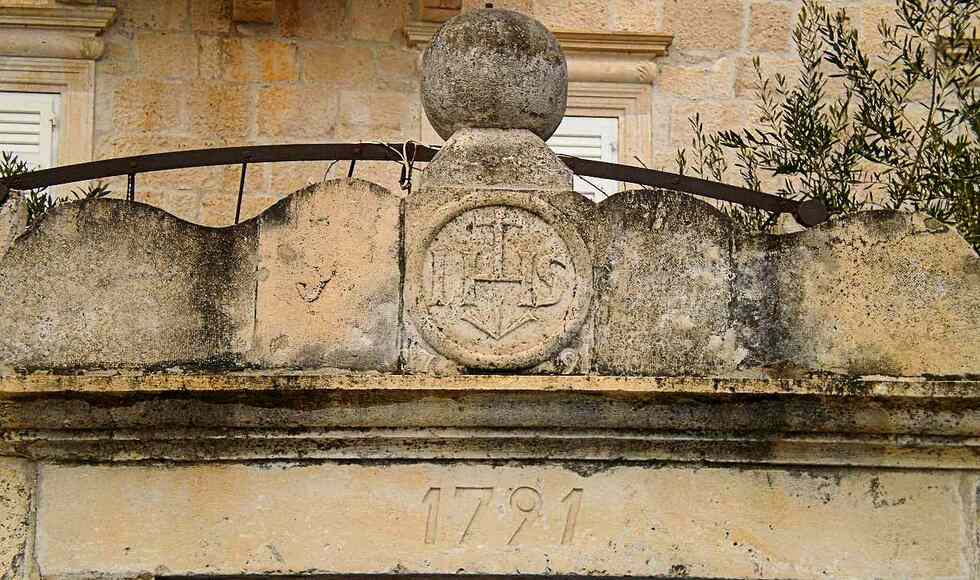
Greek and Latin Jesus
Remember I said the problem is a combination of shapes and misunderstandings? Here’s what I mean.
The Greek Name of Jesus, when written in all capital letters (as were all the earliest manuscripts of the New Testament) is
ΙΗΣΥΣ
Transliterated into the Latin alphabet, that turns out to be IESUS. But, the Divine Name was customarily shortened to a 3-letter symbol for use in early Christian iconography and church decorations. In Greek it became
ΙΗΣ
Perhaps you are now starting to see the problem. When the symbol was adopted by Christians of the Latin-speaking Western Roman Empire (Greek and Latin were the two official languages of the Empire), it took on the Latin letters. The symbol went from this ΙΗΣ to this ΙΗS quite easily.
You can see how this would be a natural mistake given the proximity of the two cultures and languages in the ancient world. In the Latin Church IHS was sometimes adopted as a short-hand symbol for the Name of Jesus, even though it makes no literal sense. (The first three letters of the Latin spelling of the Name would be IES.)
Yet, the misunderstanding seemed to win out as the symbol became a commonplace way of writing the Name of Jesus in Western (Latin Rite) religious culture.
A Different Reason
But there could also be another reason for the IHS symbol. Maybe it wasn’t a corruption of the Greek symbol for the Divine Name. Perhaps it has an entirely different symbolic value in Latin proper. And maybe this difference is close enough to the Greek to cause the confusion.
The answer might lie in the incredible story of the Emperor Constantine’s dramatic victory at the Milvian Bridge in 312 AD.
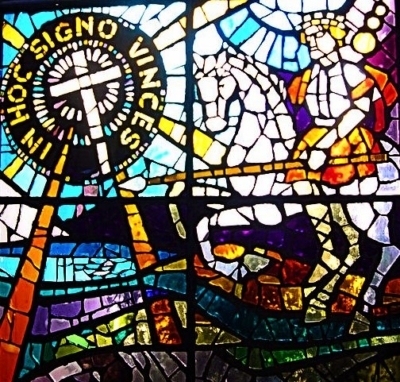
The vicious persecutor of the Church, Emperor Diocletian, died in 306 AD leaving four men in charge – two for the Greek-speaking East and two for the Latin-speaking West. The son of one of those men was Constantine the Great.
After Constantine was proclaimed Caesar, a power struggle ensued between him and his rival Maxentius. The struggle culminated in the Battle of the Milvian Bridge, outside Rome, in 312.
Contemporary sources reliably report the story of the battle and indicate that on the night before the battle, Constantine received a vision. As he looked up in the sky he saw the symbol of a cross and heard the following words spoken to him: “In this sign, you shall conquer.” He immediately directed all of his soldiers to paint the sign of the cross on their shields. And the rest is history.
After being declared sole Emperor of Rome, Constantine removed the wicked Diocletian’s decrees for persecuting Christians. He gave the Church its freedom to worship. From there the Church grew exponentially and expanded into every corner of the Roman Empire.
Why is this story important? Because the Latin version of the phrase, “In this sign, you shall conquer,” is in hoc signo vinces. The three-letter acronym for “in hoc signo” is, of course, none other than IHS.
Either/Or but Probably Both
So, in the end, we can say that the IHS mystery could either be the matter of a simple misunderstanding which occurred when the Greek symbol for Jesus morphed into its not-technically-correct Latin equivalent, or, it could be the three-letter symbol for Constantine’s victory of the Cross, which gave the Church its freedom of worship.
But why not embrace both! (That’s kind of a Catholic thing to do!)
I like to think that the shape-shifting-letter-misunderstanding is a typically human thing. It’s not at all inconsistent with the way the Church has adapted itself to innumerable cultures over 2000 years of history. The Church has managed to assimilate many diverse religious traditions from various cultures throughout its history. And she has “creatively” integrated into her religious culture myriad imperfect human realities throughout her 20 long centuries of life.
The Church could easily have adopted such a misunderstanding. It has, in fact, happened many times and in so many ways in history. This is particularly true with matters of the ancient Church about which we have very unreliable information.
One obvious example is the ubiquitous St. Valentine. What little we know about him historically is that he was a Roman soldier who converted to Christianity. And he became a bloody martyr because of his conversion. How did this fellow end up becoming the “love saint” of our culture?! See what I mean?
The Church kind of just shrugs off things like this – with the Italian attitude of “Que será, será” – and moves on.
The second theory, Constantine’s victory, is also credible as well as incredibly inspiring. As a foundational act of religious freedom, it left its traces emblazoned on Church architecture similar to the way Roman soldiers emblazoned the Cross on their shields. The decorative “in hoc signo” acronym is a testament to God’s mighty intervention in history. And it set the course for the Christian Church to flourish even to this very day. It was a truly major event! And it has become immortalized for all eternity by three small letters.
God is good. He takes us where we are and keeps it simple so we don’t miss the main message. Whenever we see the IHS symbol in a church, we should think either of the Sacred Name of Jesus or of His victorious Cross. No confusion there.

Soul Work
The other day I saw a highly imaginative and beautiful painting of the Blessed Virgin Mary as a little girl walking up the steps of the Temple. I was overwhelmed by the beauty of the image, which inspired me to love Our Lady even more deeply. I probably saw that image numerous times before, but on that particular day it struck me deeply.
Maybe the IHS could be a reminder to each of us that God uses symbols to engage us in the life of faith. Symbols, by their very nature, have various levels of meaning, and sometimes an aspect of religious culture will become very significant to us even if we had not noticed it before. That is the Holy Spirit moving us, and we should open our hearts to the message He brings.
Today, identify something – a symbol, a work of art, an inspiring story – that appeals to your religious sensibility and dwell on it for a time. Maybe it’s a particular icon or religious picture that reaches out to you. (If you need inspiration, check out the various Sacred Windows pages and archives!)
The history of the IHS symbols is a testimony to the Holy Spirit’s work in the Church. The Divine Spirit can use anything of value and of authentic humanity to inspire us to raise our minds and hearts to God.
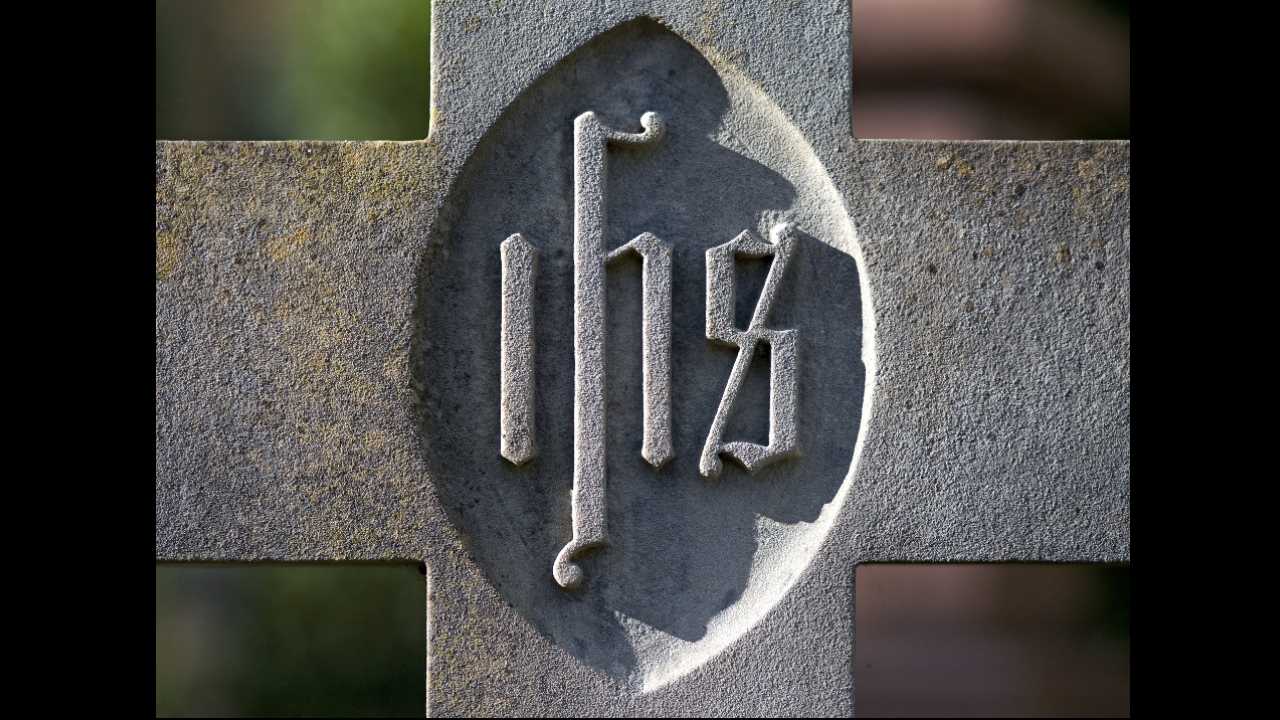

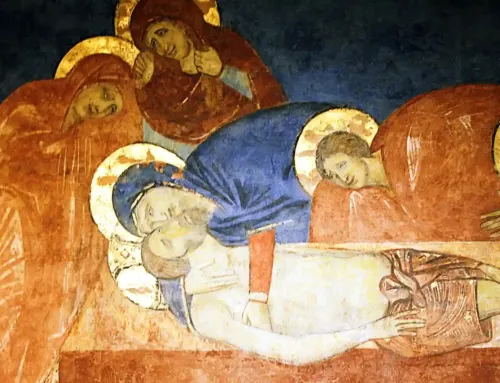
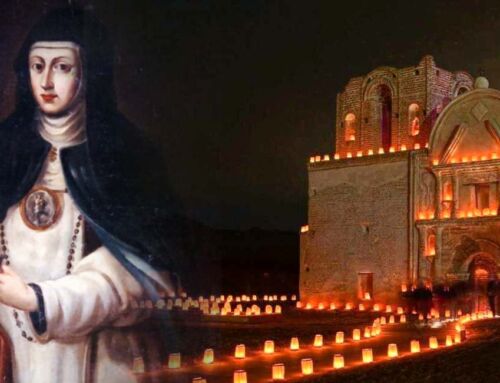

Seriously! It was the Catholic missionaries who help with the subjugation and ethnic cleansing of the American Native Americans. The Catholic religion has led the fight to purify the white race: (Even the paintings of Mary portray a white beauty). The Catholic led Crusades, witch burnings, “Holy” wars and pedophilia are also the legacy of the Catholic Church. It’s needless to go on.